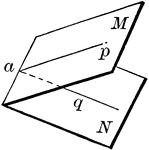
Shadows of Two Cylinders
"Two cylinders, one horizontal, the other perpendicular. The base of the horizontal cylinder is at one…
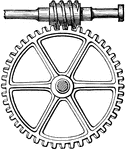
Endless Screw and Wheel
"Endless screw, a mechanical arrangement consisting of a screw the thread of which gears into a wheel…

Sum of 2 Acute Angles
Illustration of two triangles, showing the sine of the sum of two acute angles expressed in terms of…
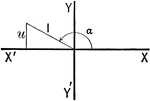
Triangle in Quadrant II
Illustration of an angle with the terminal side used to draw a triangle in quadrant II.
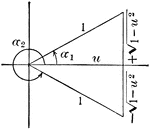
Angle Expressed As An Inverse Function
Illustration that can be used to show that when given an angle, expressed as an inverse function of…

Negative Cotangent Angles
Illustration that can be used to show that if the cotangent of an angle is negative the angle must terminate…
Law of Sines
Illustration two types of triangles that can be used to model the law of sines. "In a plane triangle…

Ambiguous Case
Illustration of one possible outcome (no triangle occurs) when discussing the ambiguous case using the…
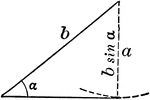
Ambiguous Case
Illustration of one possible outcome (1 triangle occurs) when discussing the ambiguous case using the…
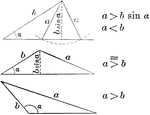
Ambiguous Case
Illustration of one possible outcome (2 triangles occur) when discussing the ambiguous case using the…
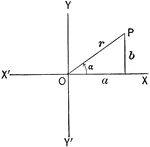
Triangle in Quadrant I
Illustration of an angle &alpha with the terminal side used to draw a triangle in quadrant I.
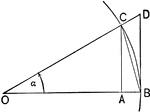
Triangles and Sectors in Quadrant I
Illustration of an angle &alpha with the vertex at the center, O, of a circle with radius OB. AC and…

Relationships In A Spherical Triangle
Illustration used, with the law of sines, to find the relation between two sides of a spherical triangle…
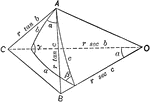
Relationships In A Spherical Triangle
Illustration used, with the law of cosines, to find the relation between the three sides and an angle…

Relationships In A Spherical Triangle
Illustration used to extend the law of cosines when finding the relation between the three sides and…
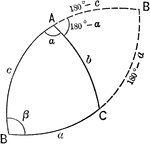
Relationships In A Spherical Triangle
Illustration used to extend the law of cosines when finding the relation between the three sides and…
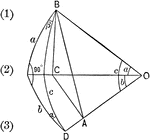
Right Spherical Triangle
Illustration of a right spherical triangle with a and b the sides, and α and β the angles…

Napier's Right Spherical Triangle
Illustration of a right spherical triangle and the five circular parts placed in the sectors of a circle…
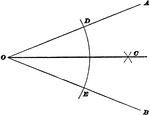
Bisect An Angle
Illustration used to show how to construct a bisector of an angle when the sides intersect within the…
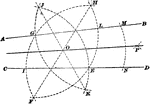
Bisect An Angle
Illustration used to show how to construct a bisector of an angle when the sides no not intersect within…

Construction Of Angle On Straight Line
Illustration used to show how to "draw a straight line through any given point on a given straight line…
Construction Of Triangle
Illustration used to show how to draw a triangle when given two sides and the included angle of the…
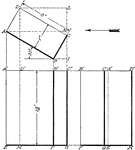
Projection Of Rectangular Prism
Illustration of the projection of a rectangular prism whose broad side makes an angle of 30° with…
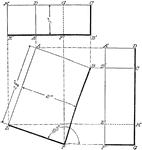
Projection Of Rectangular Prism
Illustration of the projection of a rectangular prism whose base makes an angle of 160° with the…
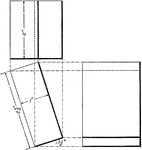
Projection Of Rectangular Prism
Illustration of the projection of a rectangular prism whose base makes an angle of 17.5° with the…
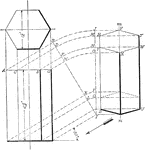
Projection Of Hexagonal Prism
Illustration of the projection of a hexagonal prism having two of its parallel sides parallel to the…
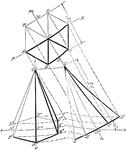
Projection Of Hexagonal Prism
Illustration of the projection of a hexagonal prism whose axis is parallel to the plane of the paper…
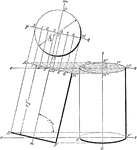
Projection Of Cylinder
Illustration of the projection of a cylinder whose axis is parallel to the plane of the paper and makes…
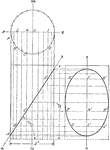
Plane Intersecting A Cylinder
Illustration of a cylinder cut by a plane making an angle of 57° with the base.
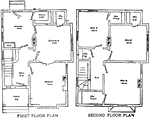
"The Baldwin" Floor Plans
From this angle it is easy to see the bay window at the front of the house. A large fireplace is situated…
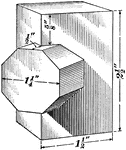
Intersecting Prisms
Illustration of the intersection of a quadrangular prism and an octagonal prism. The figures intersect…
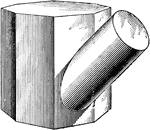
Intersecting Prism and Cylinder
Illustration of the intersection of an octagonal prism and a cylinder. The figures intersect at an oblique…
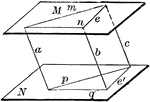
Angles In Parallel Planes
"If two angles not in the same plane have their sides respectively parallel and lying in the same direction,…

Domestic Cat Skull
"Skull of Cat (Felis catus), showing the following bones, viz. : na, nasal; pm, premaxillary; m, maxillary;…
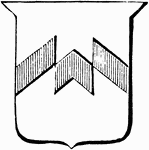
Chevron Fracted
"In heraldry, broken asunder. This condition is depicted in different ways: thus, a fesse fracted may…
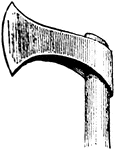
Francisca, Throwing Axe
"A battle-ax used by the Franks, of which the typical form is a head long in proportion to its width,…
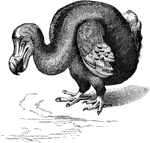
Dodo
"The Dodo, ...was an immense Pigeon-like bird bigger than a Turkey, with an aborted keel to the sternum…
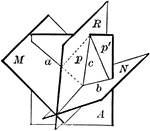
Plane Bisecting Dihedral Angle
Diagram used to prove the theorem: "Every point in a plane which bisects a dihedral angle is equidistant…
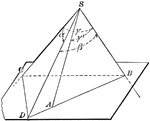
Face Angles of Trihedral Angle
Diagram used to prove the theorem: "The sum of two face angles of a trihedral angle is greater than…

Face Angles of Convex Polyhedral Angle
Diagram used to prove the theorem: "The sum of the face angles of any convex polyhedral angle is less…

Symmetrical or Equal Trihedral Angles
Diagram used to prove the theorem: "Two trihedral angles, which have three face angles of the one equal…

Two Equal Prisms
Diagram used to prove the theorem: "Two prisms are equal when the three faces about a trihedral of one…

Two Proportional Tetrahedrons
Diagram used to prove the theorem: "Two tetrahedrons having a trihedral angle in each equal, are to…
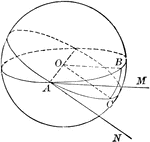
Measure of a Spherical Angle
Diagram used to prove the theorem: "A spherical angle is measured by the arc of a great circle described…
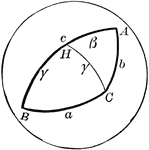
Side Comparison of Spherical Triangle
Diagram used to prove the theorem: "In a spherical triangle, the greater side is opposite the greater…

Tangent to an Ellipse
Diagram an ellipse with a tangent line that illustrates "A line through a point on the ellipse and bisecting…
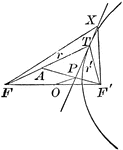
Tangent to a Hyperbola
Diagram part of a hyperbola with a tangent line that illustrates "A line through a point on the hyperbola…

Non-Vocal Primary Back Consonant
Consonants have a closed or narrowly expanded adjustment of the vocal organs, so that in their production…
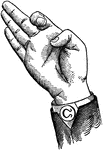
Non-Vocal Mixed Back Consonant
Consonants have a closed or narrowly expanded adjustment of the vocal organs, so that in their production…
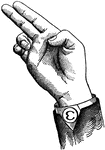
Non-Vocal Divided Back Consonant
Consonants have a closed or narrowly expanded adjustment of the vocal organs, so that in their production…
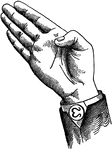
Non-Vocal Mixed-Divided Back Consonant
Consonants have a closed or narrowly expanded adjustment of the vocal organs, so that in their production…
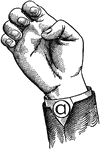
Non-Vocal Shut Back Consonant
Consonants have a closed or narrowly expanded adjustment of the vocal organs, so that in their production…

Non-Vocal Nasal Back Consonant
Consonants have a closed or narrowly expanded adjustment of the vocal organs, so that in their production…

Vocalized Primary Back Consonant
Consonants have a closed or narrowly expanded adjustment of the vocal organs, so that in their production…

Vocalized Mixed Back Consonant
Consonants have a closed or narrowly expanded adjustment of the vocal organs, so that in their production…
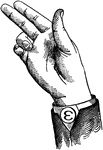
Vocalized Divided Back Consonant
Consonants have a closed or narrowly expanded adjustment of the vocal organs, so that in their production…
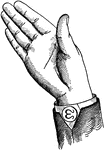
Vocalized Mixed-Divided Back Consonant
Consonants have a closed or narrowly expanded adjustment of the vocal organs, so that in their production…

